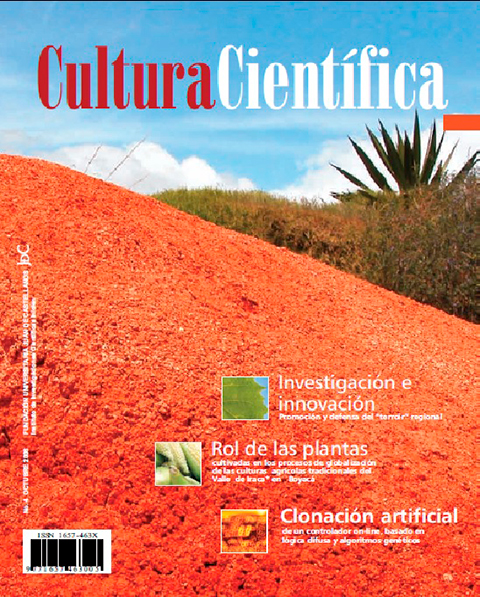Keywords:
Research, Innovation, Colonial time, Wine growing, Fruit tree growing, Terroir, Tropical cool climateAbstract
The presence of healthy and fruitful Mission vines in the region and the analysis of their characteristics, show that they were possibly introduced by competent wine growers in colonial time, probably Jesuits, to Firavitoba in the XVIIth century. The inexistence of an important colonial wine growing could be attributed to the heavy Spanish monopoly and not to natural factors. Successfull later temperate fruit crop growing, introduced from France, confirms the territorial aptitude for growing those crops. Research done in other countries and in Puntalarga, allow the explanation of some aspects of the interrelation biology of those species with local tropical cool climate and at the same time, the understanding of salient features of say climate. Fruit quality can be largely competitive at the international level. Negative appreciations published recently on the subject, are not applicable to a tropical cool climate and lake foundation.
Downloads
References
Boubals D. (1996) Reporte a la Embajada de Francia en Bogotá sobre su Misión Técnica a los viñedos de la Unión (Valle del Cauca) y de Puntalarga (Boyacá), a cargo del Ministerio de Cooperación Internacional de Francia, París.
Fregoni M. (1993) Le patrimoine viticole: sa valeur, sa transmission, son avenir, â I'heure de l'Europe. Editions Tec & Doc, Paris. 5.
Gómez F. (2004). “Zonificación, Terroir y Denominación de origen en el fortalecimiento de los campesinos viticultores en el valle del sol, en Boyacá”. Cultura Científica, Tunja No.2, pp. 15-25
_________ (2005). El vino y la vid en la construcción social: un caso boyacense.
Cultura Científica, Tunja No.3, pp. 30-39
Hidalgo L. (1993) Tratado de Viticultura, la Viticultura Americana. Mundiprensa, Madrid. 765 806.
Hoffmann K.M. (1981) Die hohe Schule des Weines, Kulturgeschichte der Weinrebe und des Weins. Moewig Verlag KG, Rastatt. 15 20
Huglin P. (1978) Nouveau mode d'évaluation des possibilités héliothermiques
d'un milieu viticole. C.R. Acad. Agric., 1117 1126
Jerez H. (1952) Los Jesuitas en Casanare, Hatos y Haciendas. Prensas del Ministerio de Educación Nacional, Bogotá. 218 234
Johnson H. (1990) Une histoire mondiale du vin. De l'Antiquitç â nos jours. Hachette, Paris. 231.
Lakso A.N. (1994) Handbook of environmental physiology of fruit crops (eds. B.
Schaffer and P.C. Andersen). Vol I, Temperate Crops. C.R.C. Press, Florida. 3 42.
Lara P.M. y Paez T. (2004) Análisis, evaluación y perfeccionamiento de los canales de comercialización de los vinos del Viñedo & Cava Loma de Puntalarga. Tesis Ing. Industrial, UPTC, Sogamoso.
Olszak N. (2001). Droit des Appellations d'Origine et indications de provenance. Editions Tec & Doc, París. 3 6.
Paillard N. (1981) Factors influencing flavor formation in fruits. Flavor 81, 3rd Weurman Symposium, Proceedings of the International Conference, (Editor P. Schreier), Munich. 479 - 494.
Quijano Niño M. (1970) Memorias. Manuscrito, Hacienda San Marcos, Sogamoso.
Quijano Rico M. (1987) El cultivo de vides nobles y la producción de vinos de alta calidad en Boyacá. Integración Boyacense, Tunja, No. 13, 13 16
Quijano Rico M. (1998), La comunicación mediada por señales químicas y las nociones de mensaje y calidad sensorial. Aplicación al desarrollo vitivinícola del Valle del Sol. Seminario sobre Viticultura y Enología Tropicales en Altitud. Loma de Puntalarga, Nobsa.
Quijano Rico M. (2004). Ecología de una conexión solar: de la adoración del sol, al desarrollo vitivinícola regional. Cultura Científica, Tunja, No. 2, pp. 5-9.
Quijano Rico M. (2005) Desarrollo Vitivinícola en Clima Frío Tropical y Producción Continua Secuencial de Uvas y Vinos. Forum CYTED IBEROEKA, Lima,
Perú.
Quijano Rico M. (2006a). Elements of a tropical cool climate “terroir” in the Colombian Andes. Trabajo preparado para el Simposio Internacional sobre los “Terroir”. Burdeos.
Quijano Rico M. (2006b). Carta a la Empresa Legis S.A., Presidencia, Loma de Puntalarga, Nobsa.
Rivas Moreno G. (1997) Elegías de Varones Ilustres de Indias, por Juan de Castellanos. Selene Impresores, Bogotá. 699.
Robinson J. (1994) The Oxford Companion to Wine. Tropical Viticulture. Oxford
University Press, Oxford. 992.
Roethlisberger E. (1993) El Dorado. Liberación y el Libertador. Edición especial, Presidencia de la República. Biblioteca Colcultura V Centenario, Bogotá. 323 353.
Sabogal H. (2005) Guía del Vino. Colombia 2006. Legis S.A., Bogotá. 144 145.
Schaetzel O. (1998) Erfolgreich Wein vermarkten. Meininger Verlag, Neuestadt,
Weinstrasse.
Schwerdtfeger W. (1976). World survey of climatology. Climates of Northern South America, Colombia. 12, 358 380.
Wagenmakers, P.S. (1994) Light relations in orchard systems. Thesis, Wageningen





